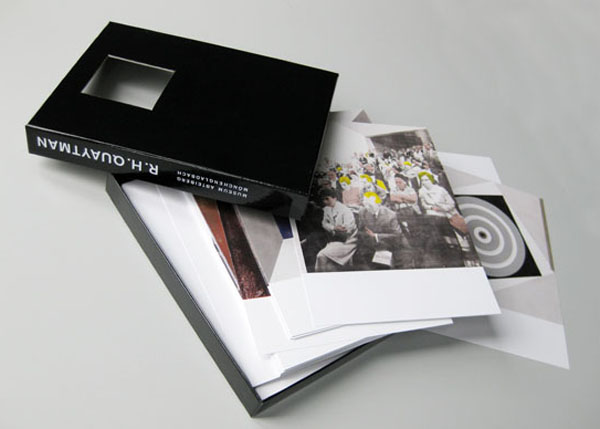Daughter of a postmodern poet and an abstract painter, Quaytman knows how she wants to operate within the structure of art history. Dalet is an artists book of her work published by Published by Museum Abeitberg.
Cryptically named after a Hebrew letter that sometimes operates as a non-sacred stand in for the Jewish names of God, Quaytman has set us up with a piecemeal visual journey of images paired with notes on each verso. The loose leaf construction unearthed from the traditional publications put out by the museum under the direction of Johannes Cladders. The work presents a controlled viewing environment geared toward an extended visual read, making for a temporally regulated succession of visual objects.
As for the prints of paintings throughout, much of the work has to do with excavation–both or the process of viewing and at the same time as a study of the often cannibalistic tendencies of art history. Works that Quaytman admires are evaluated from mechanically mediated ways of looking such as x-ray, or separated into layers via printmaking processes, in this case mostly that of silkscreen. The notes on the reverse of each page serve both to illuminate Quaytman’s decision-making while creating a relationship to the inspirational work that is reverent yet unafraid to pulp and recycle.
Artists whose works make significant appearances include Palermo, Manzoni, Beuys, and Malevich. There seems to be a theme of artists Quaytman admires who created work that was highly conceptually driven, yet manifested itself mostly in the form of objects.
This piece is number 363 out of a series of 880 boxes and 44 artists proofs, the box contains 61 separate cards. Printed in the original German, a text by Mark Godfrey about Quaytman’s project lays in the bottom of the box, along with Yve-Alain Bois’ The Tree and the Square. Bois’ writing appears in German here as well. It is reproduced for a second time in it’s original French as a Xerox of the original printing in Critique No. 357 of 1977. It has been Xeroxed and bound on soft pink paper that is as easy on the eyes as I imagine the French must be to the ear.
The project itself is everything an artist’s book should be. Dalet is presented in a fun to read format that slows the viewer down from just thumbing through pages. It is a hand numbered edition, which always feels precious in some way. The individual nature of each box sets the viewer up with a preservative attention to detail and encourages one to take extra special care of each page. It is purposefully self-aware from an art historical perspective, and pays outright homage to the contemporary masters Quaytman admires. By repurposing a book format from a pinnacle time in art history that she admires, Quaytman both gained a venue to pay homage to her predecessors and an avenue to give her work a proper home, connecting viewer experience to the work of contemporary masters through the lens of her oeuvre.
Reviewed by Matthew Hassell
Dalet is available at only one location in the US: Sequence Press.
























